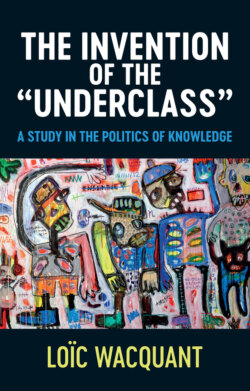The Invention of the 'Underclass'

Реклама. ООО «ЛитРес», ИНН: 7719571260.
Оглавление
Loic Wacquant. The Invention of the 'Underclass'
CONTENTS
Guide
List of Illustrations
Pages
The Invention of the “Underclass” A Study in the Politics of Knowledge
Dedication
Prologue
Concepts matter
Conceptual history meets reflexive sociology
Chasing after an urban chimera
Anti-urbanism and the fear of the (black) city underbelly
“The refuse of Europe”
“The peril of this republic”
The “spiral to urban apartheid”
Notes
PART ONETHE TALE OF THE “UNDERCLASS”
Entry
A nebulous term with “evil” connotations
Notes
1 Between concept and myth: Genealogy of a shifty category
“Something different was happening among the poor”
“It is not easy to say how they live”
Notes
2 “The tragedy of the underclass”: Policy theater and scholarship
“The greatest danger” to America’s future
Notes
3 Anatomy: The three faces of the “underclass”
1. At the origins, the “under-class” as structural position
2. The dominant schema of the “underclass” as assortment of “antisocial behaviors”
“I’ll point to a member of the underclass”
A heterogeneous and fearsome scarecrow “group”
3. The neo-ecological conception, or the neighborhood as multiplier of marginality
Notes
4 The strange career of a racialized folk devil
Notes
5 Implications for the social epistemology of urban marginality
“Car-window sociology”* en route for the Mississippi delta
“The white underclass will show its face”
Notes
Exit
The “underclass” personified: the welfare queen and the rapist – and the “subway vigilante” to the rescue
Notes
PART TWOLESSONS FROM THE TALE
Quandaries and consequences of naming
Forging robust concepts
The silences of the normal sociology of poverty and the budding science of affluence
The cautious case for precariat
Epistemic opportunity costs
Bandwagons, speculation, and turnkeys
Notes
Coda: Resolving the trouble with “race” in the twenty-first century
Notes
Appendix: The nine lives of the “underclass”
Notes
Acknowledgments
References
Index
A
B
C
D
E
F
G
H
I
J
K
L
M
N
O
P
Q
R
S
T
U
V
W
Y
POLITY END USER LICENSE AGREEMENT
Отрывок из книги
At century’s close, American social scientists, policy analysts, philanthropies and politicians became obsessed with a fearsome and mysterious new group said to be ravaging the ghetto: the urban “underclass.” Soon the scarecrow category and its demonic imagery were exported to the United Kingdom and continental Europe and agitated the international study of exclusion in the postindustrial metropolis.
In this punchy book mating intellectual history, participant observation, and conceptual analysis, Wacquant retraces the invention and metamorphoses of this racialized folk devil, from the structural conception of Swedish economist Gunnar Myrdal to the behavioral notion of Washington think-tank experts to the neo-ecological formulation of sociologist William Julius Wilson. He uncovers the springs of the sudden irruption, accelerated circulation, and abrupt evaporation of the “underclass” from public debate, and reflects on their implications for the social epistemology of urban marginality.
.....
I was also shocked to discover that the vast majority of the country’s leading experts on the question had never set foot in a poor black neighborhood and were constantly stuffing the gap between their macro-level data and everyday reality with racial commonplaces that are part of a national common sense I did not share. This discovery convinced me that, in order to break with what W.E.B. Du Bois calls “car-window sociology,”18 I needed to start from scratch through a historical-analytical reconstruction of the ghetto, on the one side,19 and from close-up observation of social relations at street level, on the other. For this, I resolved to find an observation post inside the hyperghetto to figure out from the ground up how the realities of class, race, and space shaped the social strategies and experience of young black men caught in the undertow of economic restructuring and state abandonment.
A series of chance circumstances led me to land in a boxing gym on the devastated thoroughfare of 63rd Street in Woodlawn, only two blocks from my home at the southern border of Hyde Park – but as distant experientially as another planet.20 I signed up to learn how to box as a conduit to get to know the club members; to my own surprise, I was drawn into the sensual and moral coils of pugilism and ended up apprenticing in the craft for three years.21 I followed my gym mates in their daily round and observed how they dealt with the labor market, family, welfare state, and police. This prompted me to question root and branch the existing conceptual apparatus of the sociology of caste and class in the American metropolis. Here was a cluster of men who, on paper, matched most definitions of the urban “underclass” and yet displayed a personal sense of order, a love of family, respect for authority, the pursuit of long-term goals, and an iron-clad work ethic. Pierre Bourdieu turned out to be right when he told me at the time that this boxing gym and its members would teach me more about the sociology of the (hyper)ghetto than all the tomes on the “underclass” I could read.
.....